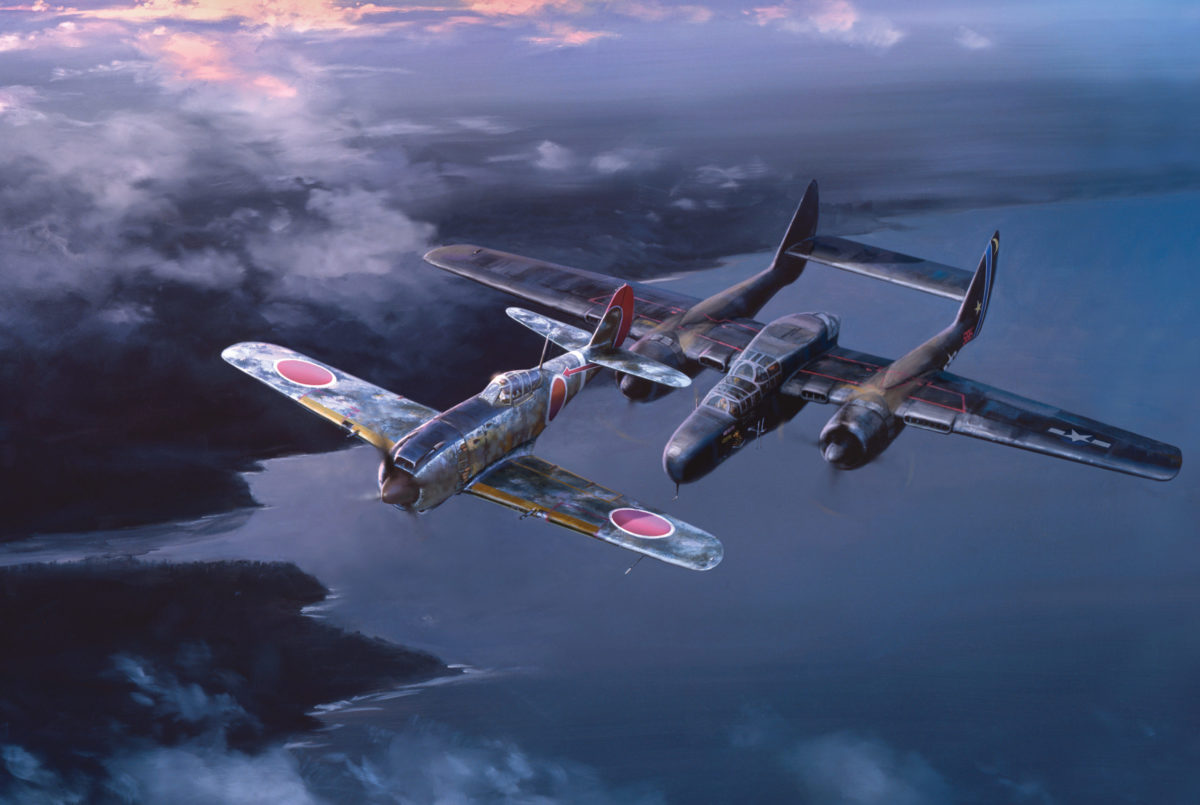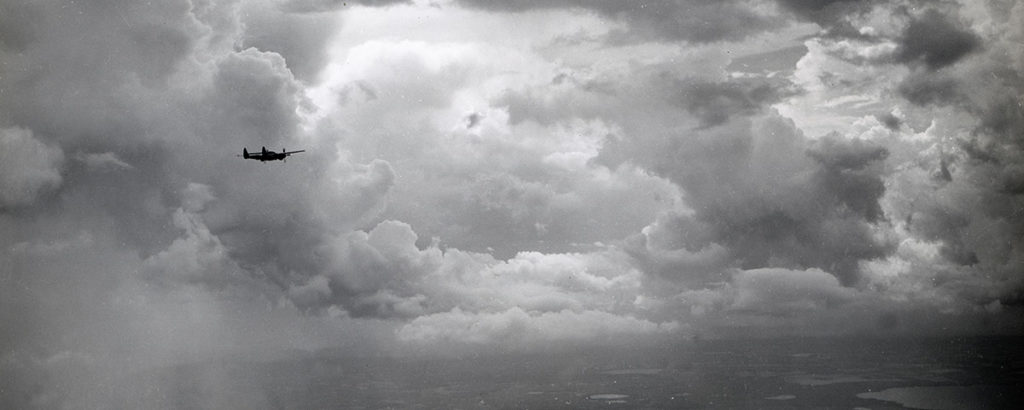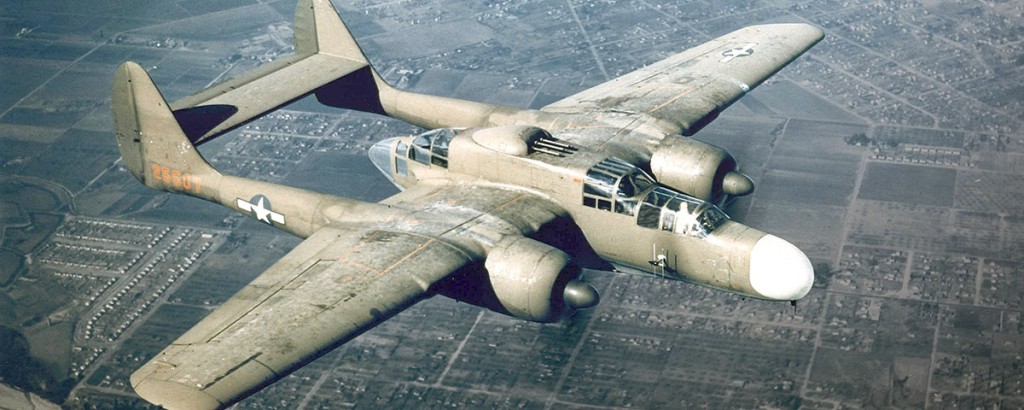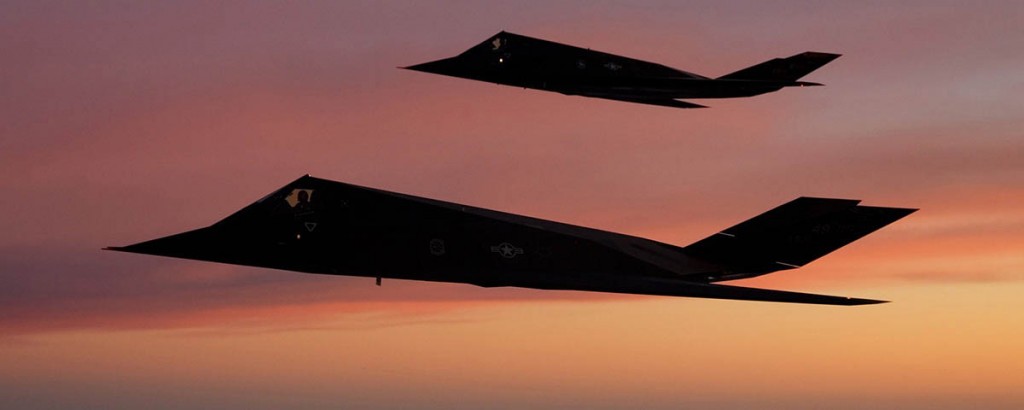Not counting bombers, transports and more specialized types, the United States produced just over 100,000 fighter aircraft of 11 different types for use in World War II. Only 674 of them were Northrop P-61 Black Widows (with another 32 delivered after war’s end). Yet the brutish twin-engine night fighter has achieved a mythic status that belies its small production run and short career—just a single year of combat at the end of the conflict.
Does the infamous Black Widow deserve such a reputation? Good question, and the answers will be all over the map depending on whether you consider the Black Widow “too cool” or subscribe to the “too slow, too low” school.
The British invented aerial night combat during World War I, when specially modified Royal Aircraft Factory B.E.2cs were first used to blunt the German Zeppelin night-bombing campaign. The spindly biplanes were fitted with fixed Lewis machine guns that fired upward at a 45-degree angle, so the airplane needed only to fly within range under the huge, notoriously flammable airships and blaze away. The Luftwaffe borrowed that idea for the venomously efficient Junkers Ju-88G and several other night fighters during the next war, calling it Schräge Musik (jazz music). The various Ju-88 marks had more European theater night victories than did all Allied night fighters combined.
The U.S., however, initially had no use for night fighters. The Army Air Corps was confident Americans were safe from attack night and day between two impossibly wide oceans, and offensive doctrine was built around daylight bombing. Unlike the RAF, the U.S. had no need to desperately search the night skies for intruders over its capital city or, later, escort its own bombers in the dark.
The 1940 Battles of France and Britain, and the London Blitz, showed that this new war was going to be different, and lessons learned by Fairey Battles, Bolton-Paul Defiants, Spitfires and Hurricanes were shared by RAF airmen with their American counter-parts. With London still in flames and Heinkels muttering overhead nightly, the British approached Jack Northrop, with whom they already were doing business (Northrop was license-building Vultee Vengeance dive bombers for the RAF), about designing and building a night fighter capable of using a new device called radar.
Within a month, the British informed the U.S. War Department of their newest developments—the cavity magnetron and centimeter-wave radar—and American military planners decided they needed a night fighter to utilize these devices. Earlier, less-sophisticated radar broadcast and received signals that could be measured in meters, which meant that antenna components had to be separated and spread piecemeal all around an airframe—on the nose, wings and fuselage. It was what gave German night fighters, especially, their characteristic appearance, flying around with bedsprings, stag’s horns and clown mustaches on their noses. Some of these drag-inducing antenna farms slowed their carriers by as much as 25 mph.
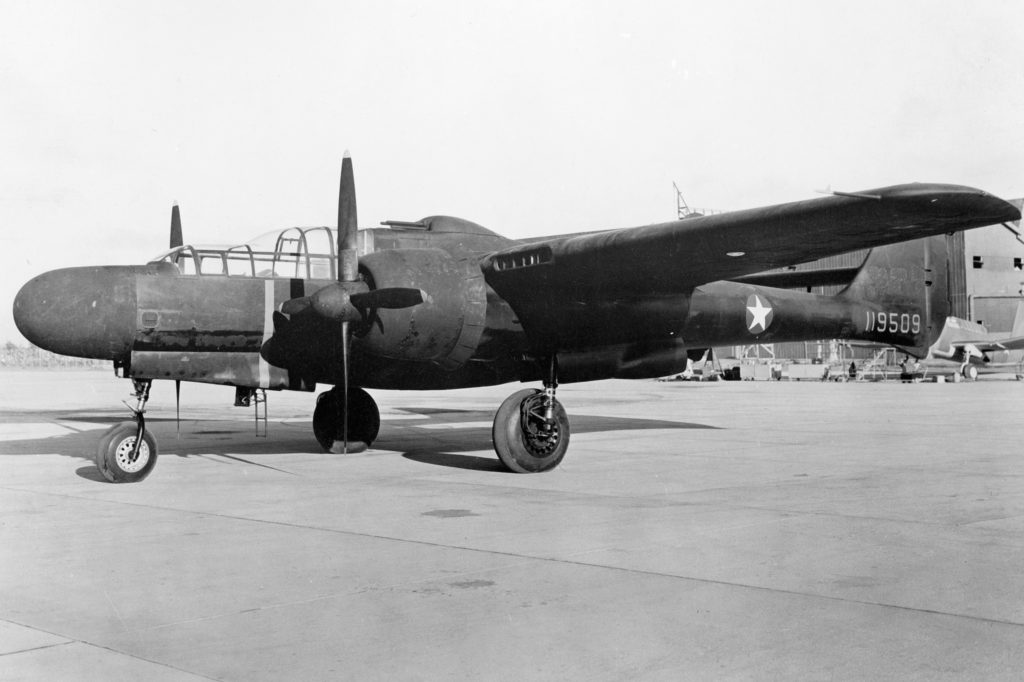
Centimeter-wave radar was lighter—albeit still heavy—and far more compact, utilizing a parabolic antenna small enough in diameter to be carried in what would become a P-61’s Jimmy Durante nose. Housing a radar dish right up front required relocation of any nose-mounted guns, of course, which was a good thing: They could be slung under the belly, in a pod or fairing like the P-61’s, virtually eliminating night vision–destroying muzzle flash. Any night-fighter pilot firing wing-or nose-mounted guns got one shot at a target and then spent the next five or 10 minutes groping around like an old man with a white cane.
In October 1940, the Air Corps, aware of Northrop’s work for the British, asked the company to design a dedicated night fighter. Jack Northrop quickly submitted the initial proposal for a heavily armed, twin-engine, twin-boom, tricycle-gear, three-man aircraft that his engineers had been drawing up for the British, and in January 1941 a contract for two prototype XP-61s was awarded to the small California company.
The P-61’s SCR-720 radar became its stock in trade. It was sometimes troublesome, sometimes unreliable, sometimes couldn’t be repaired due to lack of replacement parts, but it was an effective unit that allowed the Black Widow to become the world’s very first purpose-built night fighter. After all, if a night fighter can’t find its prey, what does it matter how fast, powerful or well-armed it is?
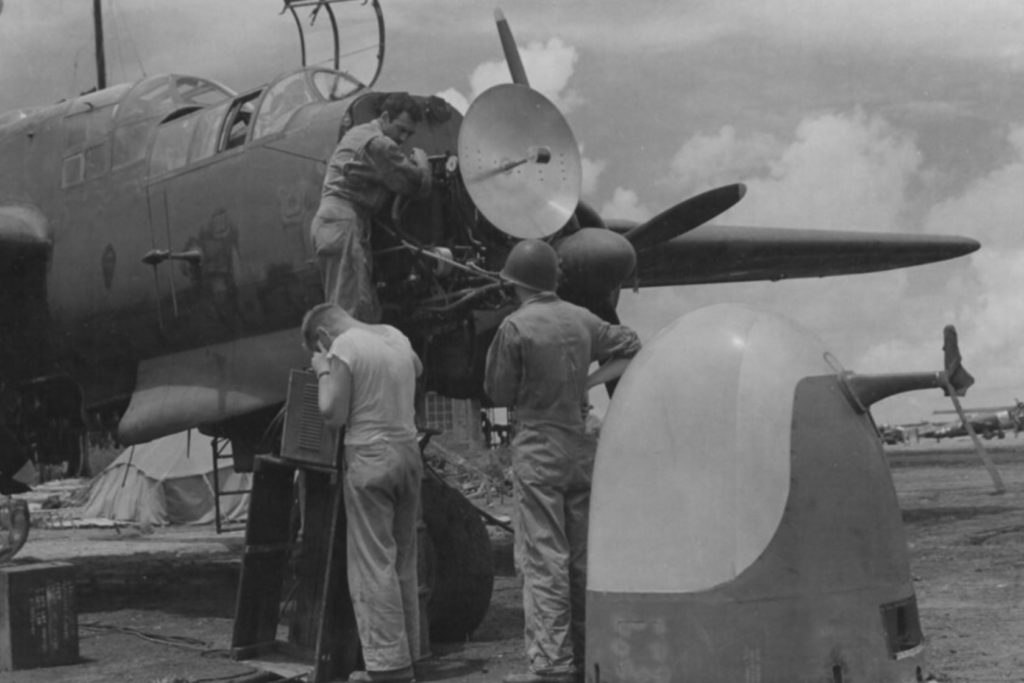
Unfortunately, the P-61 wasn’t particularly fast, and it turned out that did matter. All the P-61A and -B Black Widows that saw combat had supercharged but unturbocharged Pratt & Whitney R-2800 engines. When the airplane was designed, the thinking was that a night fighter would loiter at altitude and await its prey for a ground-controlled intercept, but that’s not always how it worked in practice. Night fighters had to be able to climb hard and climb high, and then stern-chase fast to overhaul a bogey. The Black Widow didn’t have a particularly good rate of climb—only 500 feet per minute at 20,000 feet, which is roughly the climb rate of a small, single-engine lightplane—and it rapidly ran out of grunt at 20K as the superchargers reached their limit. (Admittedly, there were also concerns about the reliability and throttle response of early R-2800 turbos.) At war-emergency power, a P-61 could accelerate to about 370 mph; for such power output, it had a 24-gallon water tank good for perhaps 15 minutes of water injection.
The biggest knock against the Black Widow is that it simply wasn’t fast enough to do the job for which it was designed, an opinion held by a number of influential colonels and generals. Colonel Winston Kranz, director of USAAF night-fighter training, said: “The P-61 was not a superior night fighter. It was not a poor night fighter, it was a good night fighter, but it did not have enough speed.” In July 1944, just as the first P-61s were arriving in the ETO, Lt. Gen. Carl Spaatz insisted upon the “great night-fighter flyoff,” between a Black Widow and a de Havilland Mosquito NF Mk. XVII. The Mosquito was an early version of what, as the NF Mk. XXX, would become by far the best Allied night fighter of the war, and Spaatz wondered if maybe the USAAF should be flying them in place of the ponderous Northrop.
Controversial ever since, the contest saw the P-61 apparently handily outfly the British wooden wonder. Longtime National Air and Space Museum researcher and aviation historian Dana Bell is convinced that “the results were rigged to give the American crews more faith in the P-61s they were about to take into combat.” Bell points out that the American P-61 crew was stoked, competitively selected and up for a fight, while the RAF pilot wasn’t even aware that it was a contest; that the P-61’s engines had been tweaked and tuned by Pratt & Whitney factory representatives, while the Mosquito, a 1942-vintage machine with single-stage Merlins, had simply been taken off an operational flight line; and that the tests were never flown at altitudes higher than 20,000 feet, the level of the P-61’s maximum efficiency.
“The final report was never shown to one of the two American evaluators,” Bell reveals. “Forty years later, he still thought the Mosquito had won and was surprised to see a report recommending the P-61—a report onto which his signature had been forged.”
Ultimately, the British had no interest in winning the flyoff. A clean victory would only have meant they’d have been required to hand over too many of their priceless Mk. XXX Mosquitos to their ally. And the Americans loved their Northrop behemoth in spite of it all. One ETO night-fighter squadron was scheduled to revert to Douglas P-70s—the night-fighter version of the elderly A-20—but the squadron’s pilots reportedly threatened to hand in their wings if that happened.
In the Pacific, the P-61s suffered an embarrassment, however, when Far East Air Force Lt. Gen. George Kenney found their performance so lacking during the Battle of Leyte Gulf that he requisitioned a squadron of radar-equipped Marine Grumman F6F-5Ns to replace them. The Black Widows were sent to a backwater island airstrip.
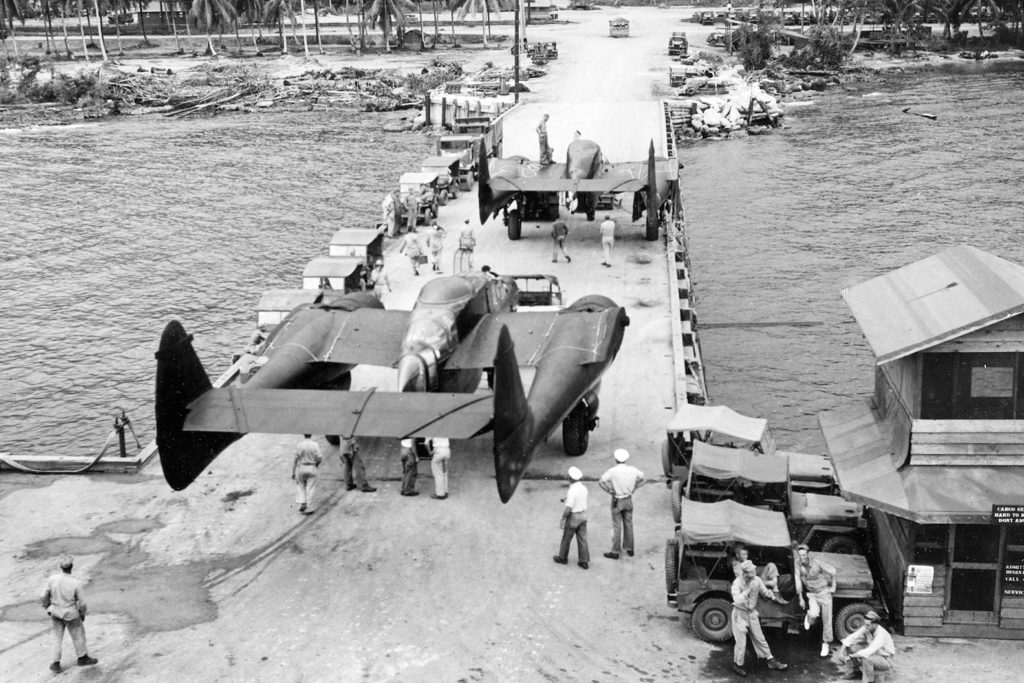
It was also in the Philippines that one of the strangest yet most productive uses of a P-61 occurred. On January 30, 1945, the Japanese prison camp at Cabanatuan was to be attacked by Army Rangers and Filipino irregulars, for the U.S. knew that the Japanese were within hours of executing their contingent of American and British prisoners as MacArthur’s troops advanced. As part of the raid, a Black Widow was scheduled to do a low-altitude flyover of the prison to distract the guards while the raiders crept as close as possible to the camp fencing. The P-61 pilot did orbits while shoving the mixtures to full rich to pump out black exhaust smoke, and flipping mag switches to produce backfires. The Japanese guards were totally distracted by what they figured was about to be a fiery crash into the jungle, and the Cabanatuan raid overwhelmed them.
Among the Cabanatuan prisoners were Brits left behind at the fall of Singapore, in the earliest days of the Pacific War. When they saw the unearthly black shape of the P-61 close overhead, some of them became convinced that the Germans had won the war, for they felt that nobody but the Luftwaffe could have fielded such a malevolent machine.
In late October 1944, the U.S. Navy hosted a “joint fighter conference” at its new Patuxent River test center in Maryland, with aircraft from not only the Navy but also the Army, the RAF and the RCAF, all of them to be flown and assessed by active-duty pilots from all four air arms. A P-61 was one of the airplanes evaluated, and among the 11 U.S. fighter types represented, it did not fare well. (Much of the information that follows is from Francis H. Dean’s outstanding book America’s Hundred Thousand: U.S. Production Fighters of World War Two, which should be part of every serious aviation enthusiast’s library.)
Of course the P-61 was by far the heaviest of all U.S. WWII fighters—more than twice as heavy, at a baseline gross weight of 31,100 pounds, as a P-47. Even with a double helping of 2,000-hp R-2800 engines, this gave it the highest power loading of all fighters as well, which was not helped by its highest-in-category flat-plate drag area. The double-cockpit crew nacelle, with a second windscreen for the gunner seated behind and above the pilot, was a draggy arrangement. General Hap Arnold, upon first viewing a fully equipped P-61 parked on a flight line, turned to procurement chief Maj. Gen. Oliver Echols and asked, “Who is responsible for this assortment of built-in headwinds?” He had a point. The result was a speed deficit, which had from the outset been the P-61’s bad rap. A Black Widow cruised at roughly 225 mph—B-25 performance—and could summon about 365 mph flat out at 20,000 to 24,000 feet.
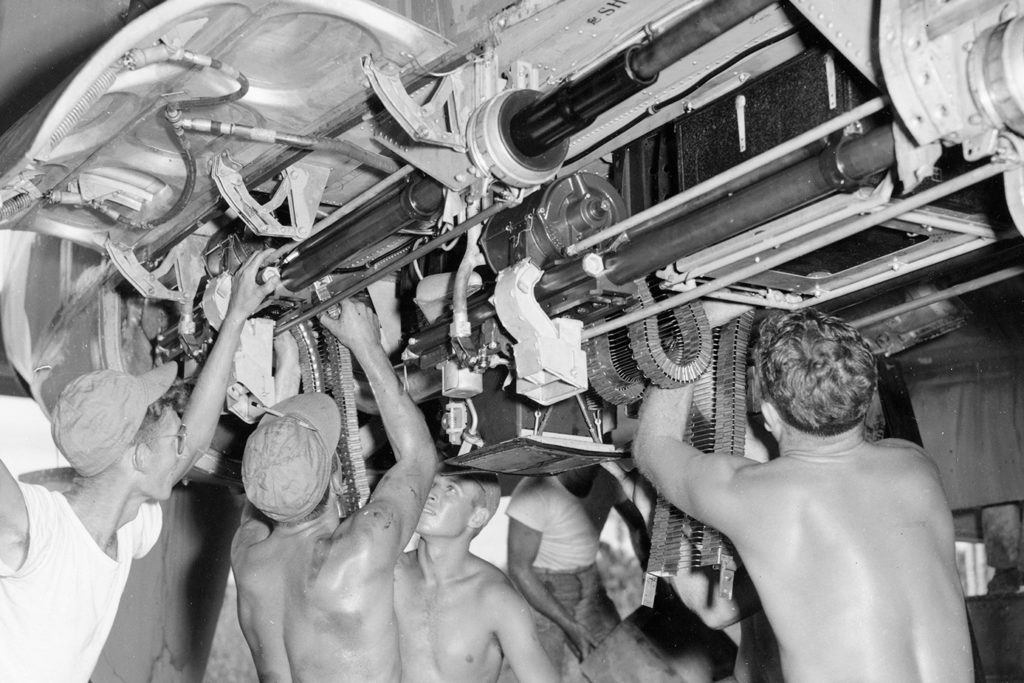
The P-61 was heavy for a reason: It needed to carry a crew of three (sometimes reduced to two—pilot and radar/radio operator—when no gunner was needed), four heavy cannons and ammunition, sometimes a four-gun top turret, adequate fuel and a huge number of heavy vacuum-tube radio and radar boxes. A casual count shows at least two dozen, some the size of orange crates, scattered throughout the crew nacelle.
The best available radio gear was needed because P-61s were often ground-controlled during the initial stage of intercepts. A controller using ground radar would vector the Black Widow toward a bogey until the airplane’s own radar, which had a range of between five and 16 miles depending on atmospheric conditions, picked up the target. The P-61’s radar operator would then take over guidance, with the pilot soon able to pick up the blip on a tiny panel-mounted display. (Most pilots didn’t bother, instead allowing the RO to continue with verbal vectors.) The final stage of such a pursuit required the pilot to swing into place a pair of hands-free night-vision binoculars to make a visual ID of the target and confirm that it was a bandit and not a friendly.
This was not a trivial pursuit. P-61s in the ETO shot down several Allied aircraft, including at least one Mosquito and an A-20. Official records show that no Black Widow was ever shot down by an enemy fighter, though some claim an Fw-190 downed one.
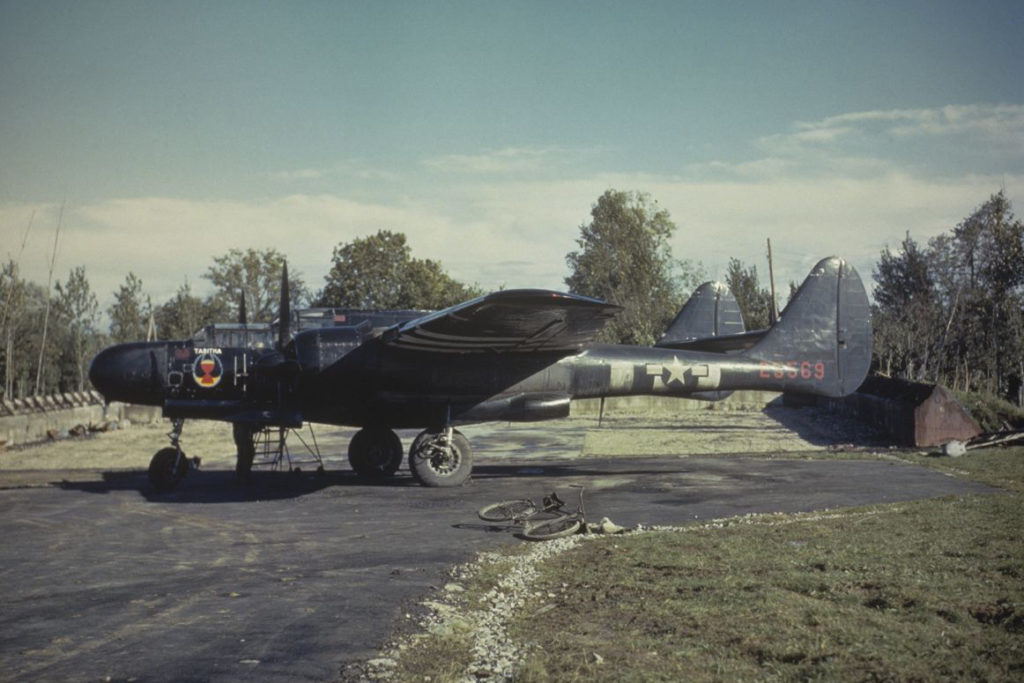
A P-61 also required a relatively long runway for takeoff at such weights, but it lifted off at a gentle 100-110 mph indicated. And Vmc—the minimum speed at which the airplane could be controlled if one engine failed—was only 120 mph, or 140 mph when heavily loaded. This meant that the dangerous window between liftoff and single-engine controllability was brief. (While climbing out within that window, a pilot’s only choice if an engine failed was to close the throttle on the good engine and land—or more likely crash—straight ahead.)
There have been published reports of the Black Widow’s “remarkable short-field capability,” perhaps in some cases an assumption based on its nearly full-span slotted flaps. But if short takeoffs were achieved, they must have been done with lightly loaded examples or using nonstandard techniques that would considerably extend the time needed to achieve Vmc, for the Pax River conference placed the P-61’s ground roll 19th among 20 different fighter variants tested, exceeded in distance only by a heavily loaded P-47D.
MORE COMBAT IN THE DARK OF THE NIGHT
Most of a Black Widow’s handling qualities seemed to be excellent, other than the need for extreme yoke deflection to achieve roll effectiveness at slower speeds, which made flying in turbulence challenging. Stalls were benign and straight ahead, pilots all agreed, and it was surprisingly maneuverable for an airplane with heavy engines and tail booms well outboard of the centerline. Still, one pilot at the 1944 fighter conference adjudged the P-61 to be “cumbersome as a night fighter, hopeless as a day fighter.” Its most surprising talent was the ability to turn very tightly, especially at slow speeds. The Black Widow gobbled up Corsairs and handily out-turned the vaunted P-51 Mustang. Unfortunately, this was a quality of little use to a night fighter, which typically attacked in straight and level flight from dead astern.
But rolling into that turn was another matter. A P-61 could roll at 50 degrees per second at 330 mph, with lesser roll rates at slower speeds, meaning it took a Black Widow more than seven seconds to do a full aileron roll. A P-51 could do almost twice that laterally.
Actually, a Black Widow had almost no ailerons. For roll control, P-61s had 10-foot-long panels that rose out of the upper surface of each wing, near the trailing edge. These “spoiled” the lift to drop a wing when the airplane’s schoolbus-size control yoke was deflected in its direction. There were very small “ailerons” near the tip of each wing, but they had no effect on roll rate; their purpose was to provide aerodynamic feedback to the pilot, since the spoilers couldn’t be felt through the yoke.
Why spoilers? So that nearly the entire trailing edge could be devoted to flaps, which not only lowered landing speed but helped the Black Widow to decelerate rapidly once it had overhauled its quarry and was approaching from dead astern to a position to fire its guns. A 15-ton airplane is hard to slow. Imagine driving a car and taking your foot off the accelerator with the transmission in neutral—freewheeling. Deceleration is almost imperceptible. So a night fighter needs to be able to quickly drop very effective flaps (or some other aerodynamic device) or it will sail past its target. Wartime P-61s had no dedicated speed brakes other than their flaps.
The XP-61 prototype had an unusual form of flaps called Zap flaps, after inventor Edward Zaparka, an engineer who worked on the P-61. (He had, however, patented the flaps before joining Northrop.) Zap flaps were unslotted split flaps that moved aft as they dropped from under the upper surface of the wing, thus lengthening the apparent chord line of the wing and increasing lift while simultaneously providing drag. The manufacturing tolerances necessary for them to trundle smoothly along their tracks proved un-attainable, however, so all Black Widows built after the first proto-type had conventional single-slotted flaps.
Another design hangup was buffeting caused by disturbed airflow over the horizontal stabilizer and elevator whenever the P-61’s top turret was traversed. The four .50-caliber barrels poking into the slipstream when they pointed anywhere but straight ahead were in a direct line with the horizontal tail, and their effect was strongly felt. That problem was never satisfactorily solved, so the top turrets were either deleted or locked in a straight-ahead position.
Well over half of all P-61s were delivered to their squadrons without top turrets. This allowed the gunner to stay on the ground, since now the upper guns and the belly-pod cannons could be fired by the pilot. Some Black Widow units field-modified their airplanes to seat the radar operator in the gunner’s chair right behind the pilot, which must have been more pleasant than working from the lonely aft compartment, often facing backward like a kid in an old station wagon’s way-back, sealed off from the rest of the crew.
Not that a P-61 cockpit was a particularly friendly space. Most pilots at the Pax River fighter conference rated it as “cluttered,” “badly designed” and “too complex,” with “lousy visibility” to boot, despite all the glass area. Much of what was behind the pilot was obscured by the gunner and his station, and the latticework of green—-house structure didn’t help. The multifaceted canopy also led to glare and reflection problems during night attacks. Of all U.S. fighter types, only the P-38L Lightning was voted to have a worse cockpit that the Black Widow. Perhaps fighters with steering-wheel yokes rather than joysticks bore an automatic deficit in fighter-jock minds.
Some warbird enthusiasts have assumed that it was remarkable for a twin-engine airplane as large as the P-61 to have a single pilot, but in fact two-man crews were a particularly American obsession. Virtually all British and German twins, and even the four-engine Avro Lancaster, had single-pilot cockpits. Even if there were two men up front, as in the Lancaster and the Mosquito, only the one on the left had flight controls.
The ultimate P-61, the 430-mph C model, never made it into combat. Taking into account the basic failings of the P-61A and B—unspectacular climb and speed, and limited range—the P-61C was fitted with turbosupercharged R-2800s, the top turret was permanently deleted and a big fuel tank was installed in the now-available space in the center of the crew nacelle. Internal fuel capacity went from 646 gallons to 1,158, with new underwing hard points available to carry yet another 1,248 gallons max, at gross weight making the P-61C a 20-ton fighter. (A loaded P-47D typically weighed 7 tons.) The C also had “fighter brakes”—large perforated panels that rotated out of the wing upper and lower surfaces to rapidly slow the airplane.
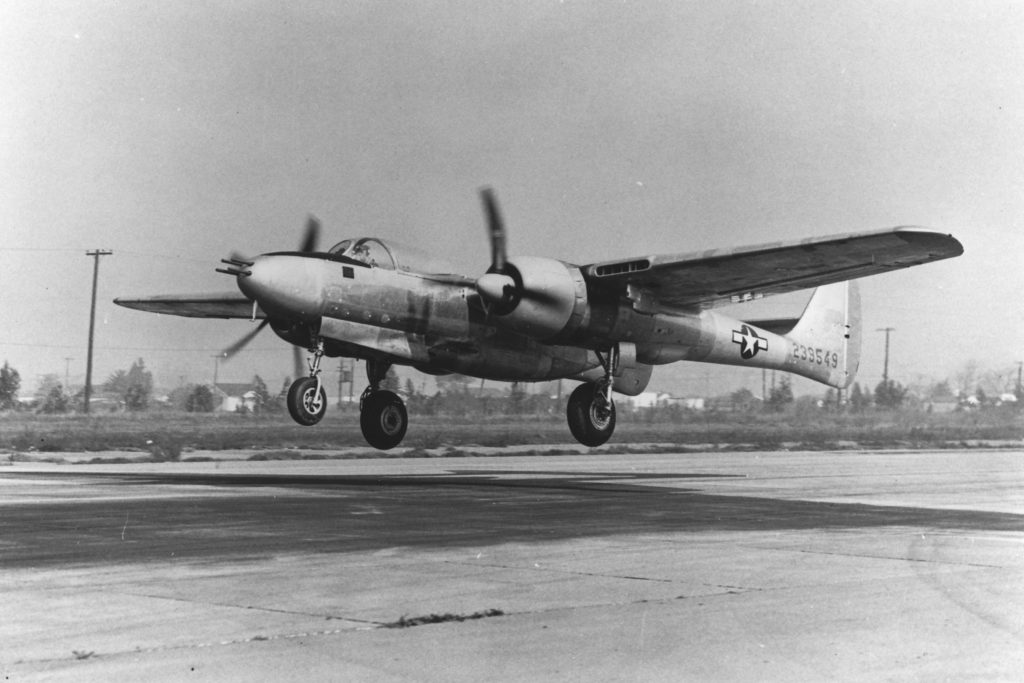
But it was too late. The Black Widow’s web was about to be broomed away by several new night-fighter jets, first among them Northrop’s own F-89 Scorpion, plus the Lockheed F-94 Starfire. (The P-61’s immediate and direct replacement, just in time for the Korean War, was the North American F-82 Twin Mustang.) The Black Widow airframe’s final form was the F-15 Reporter, a small batch of bubble-canopied reconnaissance versions with a name as nerdy as the P-61’s was arrogant. If “Black Widow” was the war’s most aggressive nom de guerre, “Reporter” was its blandest.
Some of the P-61’s most valuable work was done after WWII. A number were assigned to weather reconnaissance duty, and they compiled invaluable meteorological data in those pre-satellite days. Thirteen P-61Cs and F-15s flew as part of the Weather Bureau/NACA Thunderstorm Project, from 1946 through 1949, providing a foundation for a real understanding of how thunderstorms are generated, what tremendous powers lie within them and how radar can be used to avoid the worst weather .
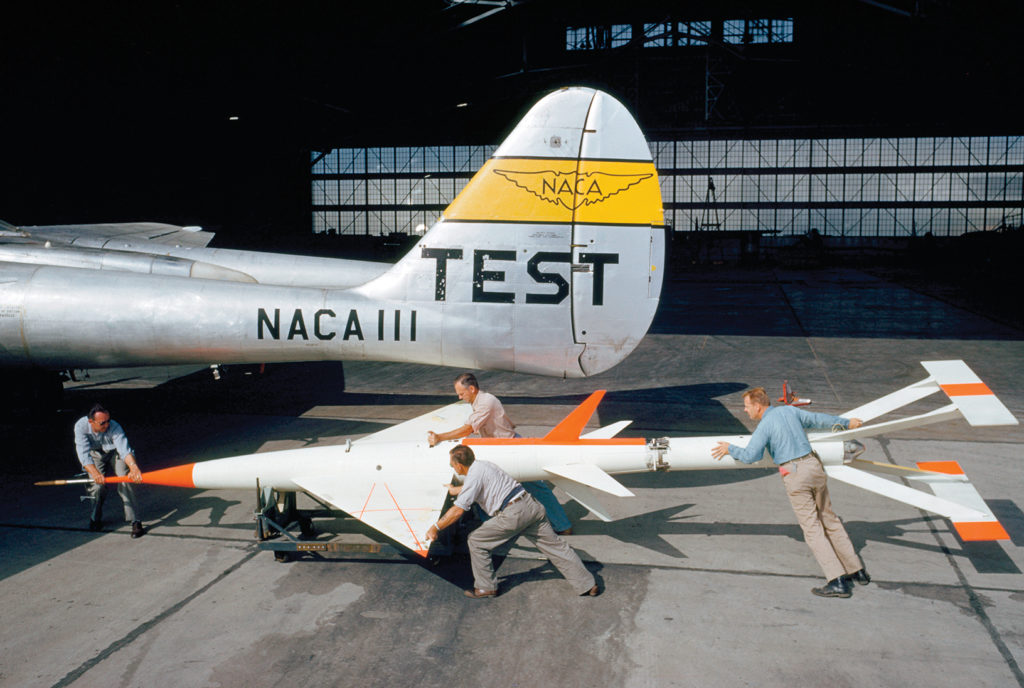
A P-61B flew as part of the development of the first U.S. ejection seat, and a brave AAF volunteer was successfully ejected from it in April 1946. NACA (predecessor of NASA) used two P-61Cs to drop-test drones to collect valuable data on sweptwing flight.
No P-61s flew in the Korean War. The last operational Black Widow in the Pacific left Japan in May 1950, bound for the boneyard a month before the North Korean invasion of South Korea, but photomapping of the Korean Peninsula by P-61s during the late 1940s proved invaluable.
Despite its brief wartime service and low shoot-down count (a total of 127 enemy airplanes, 18 V-1 buzz bombs and one B-29 flying on autopilot after the surviving crew had bailed out over Iwo Jima), it can’t be said that the P-61 was a failure. Black Widow air combat victories were necessarily one at a time, the result of lengthy solo pursuits rather than swirling 60-second dogfights.
The P-61 was in fact a remarkable response to the mission set for it, but that mission had already changed before it got into combat. Northrop, a small manufacturer that rose to meet a challenge, did an amazing job of building a sophisticated, new-technology airplane that had no precedent. They didn’t adapt an earlier design to become a night fighter or base the P-61 on anything that already existed. They started with a clean sheet of paper and invented the first all-weather, day/night interceptor. In that sense it was the beginning of today’s anytime/anywhere/24-hour U.S. Air Force.
It was the start of something else big, too. Oddball specialty airframer Northrop Aircraft, once small enough that it could be given the night-fighter assignment without disturbing the work of such long-gone industry giants as Republic and North American, is today, as the Northrop Grumman Corporation, the fifth largest defense contractor in the world.
For further reading, contributing editor Stephan Wilkinson suggests: Northrop P-61 Black Widow: The Complete History and Combat Record, by Garry R. Pape; Northrop’s Night Hunter P-61 Black Widow, by Jeff Koln; and Queen of the Midnight Skies: The Story of America’s Air Force Night Fighters, by Garry R. Pape and Ronald C. Harrison.
GET HISTORY’S GREATEST TALES—RIGHT IN YOUR INBOX
Subscribe to our HistoryNet Now! newsletter for the best of the past, delivered every Monday and Thursday.

